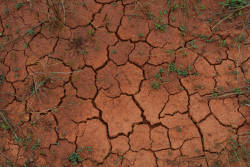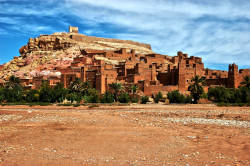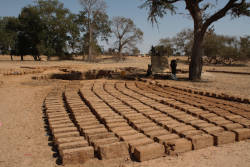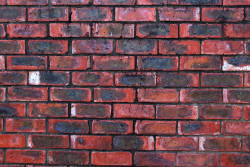Clay Mines
Clay Pits - Brick Pits
Clay is a soft residual of the weathering of rocks which is fine-grained and composed predominantly of hydrous aluminum silicates. Clays fall into six general categories: kaolin, ball clays, fire clays, bentonite, common clays and Fuller’s earth.




Clay is a residual of rock erosion. Crystalline rocks, consisting of all sorts of silicates, especially field spars, erode never completely. The minerals which are most resistant against corrosion are hydrous aluminium phyllosilicates like kaolinite (Al2Si2O5(OH)4). The remains of the erosion are often tiny grains (< 2 µm) of those silicates which tend to contain a high amount of water. If they dry, they lose volume and get cracks, which are caused by the shrinking. If they are wet, they are waterproof. Sometimes those clays are covered by other sediments and re-transformed into rocks by diagenesis. Those rocks are called mudstones or shales.
Recent deposits of clay, or shales with little diagenesis are often mined for various purposes. Common clay is used for sealing landfills from the groundwater, better qualities are used for adobes, bricks, ceramics and even porcelain. The products are as various as the chemical composition of the clays. A special kind of clay called bauxite, after the French village Le Baux, is an aluminium oxide and the main source of aluminium. In other words it is an ore. The aluminium is retrieved by reducing the aluminium oxide with electric currency. Other important kinds of clay are kaolin and bentonite.
The use of clay is ancient, mining and subsequent treatment too. Probably the first use was pottery. Clay is easily dissolved in water, but after being heated it becomes hard, waterproof and water tight. It is useful to store food and even cook. Unfortunately it becomes also brittle.
Adobes are a very old technology to build houses. The clay is simply slurried, cleaned a little and then dried in moulds. The result is quite stable bricks which are also breathable and regulate the indoor climate very well. You can improve the quality even more by adding straw. The problem with outdoor use is that it is water-soluble, so this construction method only works well in semi-arid and arid regions. However, the use of clay indoors has also become very popular in our latitudes. It regulates the indoor climate very well, insulates and does not contain any harmful substances. Burning the adobes results in bricks, a common way to build houses in many humid countries.
Main reason for the wide use of clay is the easy mining of the clay. Almost all clay mined on earth is mined in huge open-cast mines or quarries. Its quite simple, just use an excavator and a conveyor belt for transport. But sometimes, the clay was even mined underground. These are mainly clays which are needed for special ceramics, especially porcelain.
- Examples
 Tonbergbaumuseum Westerwald
Tonbergbaumuseum Westerwald Phosphatières du Cloup d’Aural
Phosphatières du Cloup d’Aural Musée des Gueules Rouges du Var et de la Bauxite
Musée des Gueules Rouges du Var et de la Bauxite
 Search DuckDuckGo for "Clay Mines"
Search DuckDuckGo for "Clay Mines" Clay pit - Wikipedia (visited: 19-OCT-2023)
Clay pit - Wikipedia (visited: 19-OCT-2023) Clays (visited: 19-OCT-2023)
Clays (visited: 19-OCT-2023)
 Index
Index Topics
Topics Hierarchical
Hierarchical Countries
Countries Maps
Maps